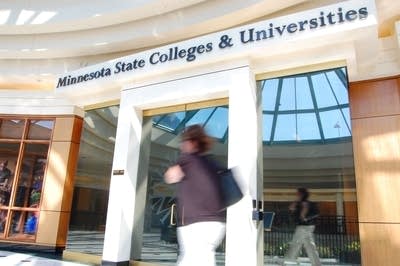MnSCU approves tuition increases
Go Deeper.
Create an account or log in to save stories.
Like this?
Thanks for liking this story! We have added it to a list of your favorite stories.

Students will need to shell out more money to attend college in Minnesota next year. The Minnesota State Colleges and Universities board of trustees Wednesday voted to raise tuition by about 4.5 percent at state universities and two-year colleges. Last year, MnSCU raised tuition by 3 percent.
The increase means students at the state's community and technical colleges will pay an average of $4,902, about $200 more for classes next year -- an increase of 4.4 percent. At the seven MnSCU universities, students will pay about $300 more -- a 4.8 percent increase to $6,596.
MnSCU's chief financial officer Laura King says the increase comes in part to make up for a 35 percent decline in state funding over the past two years.
"They would rather not raise tuition at all if they had their first choice. But we're trying to keep the doors open," she said.
Turn Up Your Support
MPR News helps you turn down the noise and build shared understanding. Turn up your support for this public resource and keep trusted journalism accessible to all.
The increase is in line with what's happening in surrounding states. In North Dakota, for example, tuition at the state's four-year colleges is going up 3.5 percent. In South Dakots, it's 4.6 percent, and in Iowa, it's 6 percent.
Across the country there are stories of universities and higher ed systems considering bigger tuition increases as colleges face shrinking state funding.
In Ohio, tuition at public universities is going up 7 percent. In Virginia, students are facing a 10 percent increase. And Arizona is considering a 10 to 20 percent increase in tuition next year.
With that in mind, Travis Johnson is relieved that MnSCU's tuition is only going up 4.4 percent. Johnson is a student at Lake Superior College in Duluth, and president of the Minnesota State College Student Association.
But Johnson says he and other students are worried about bigger increases in the next several years, as federal stimulus money that colleges have been using to hold down tuition finally runs out.
"We're a little bit nervous about the cliff that's to come, and what kind of potential tuition increases we could see down the line," said Johnson. "We're just hoping that the system can remain cognitive of the tuition increases staying as little as possible for students."
MnSCU officials don't know what will happen to the price of tuition after next year, although they say they're more likely to cut back on programs and student services than dramatically increase tuition.
The end of the flow of stimulus money colleges have used to hold down tuition has the University of Minnesota concerned. A year at the U currently costs about $11,000.
U of M spokesman Dan Wolter says the college will use federal money to keep its tuition increase down to 4.5 percent for in-state students next year.
"The great unknown, I think, of course is for 2012-2013 when the federal stimulus dollars go away. Those are clearly some of the big issues we'll be dealing with in the future," said Wolter.
The University of Minnesota Board of Regents will set tuition levels in June when they meet to approve next year's budget.
An increase in tuition at the state's private colleges next year is on par with what public colleges are planning.
The 17 schools in the Minnesota Private College Council plan an average increase of 4.5 percent, about the same as last year. A year of tuition at one of Minnesota's private colleges now averages just under $30,000.
"That's the lowest increase in at least 30 years, going back to 1978-79," said the group's president Paul Cerkvenik.
Cerkvenik says the economy is the reason for the rather small increase.
"The slowdown in the economy is making it even more difficult for students and families to afford colleges, and I think the small increases are a reflection of the sensitivity to the economy," he said.
The increase in college tuition next year may be relatively small, but it comes on top of years of increases. Over the last decade, the cost of tuition at Minnesota's public and private colleges has gone up 81 percent.
Dear reader,
Political debates with family or friends can get heated. But what if there was a way to handle them better?
You can learn how to have civil political conversations with our new e-book!
Download our free e-book, Talking Sense: Have Hard Political Conversations, Better, and learn how to talk without the tension.





